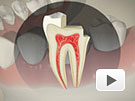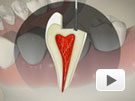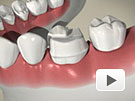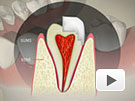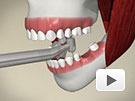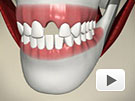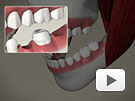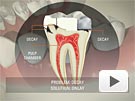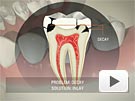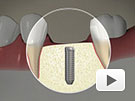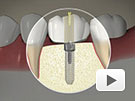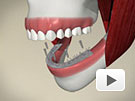Restorative Dentistry

ID Dental - White Composite Fillings
At ID Dental we are pleased to offer our clients an alternative to traditional Mercury Amalgam fillings and a more affordable option to Ceramic Restorations. Many of our clients find that these fillings are esthetically pleasing (as they are tooth colored) and this makes them a compelling choice to other restorations options.
So with the decline in the use of amalgams by dentists, over 70% over the fillings created today are composed of resin or synthetic composite materials. Composite fillings are made up of acrylic and glass particles, and contain no mercury or other metals. The filling material is white or matched to the colour of your teeth and has a very natural appearance. However, it should be noted that these types of fillings, while improving strength because they are fused or bonded to the tooth, are only a short-term solution for larger fills, with a life of around two years.
How is a composite filling placed?
Following preparation, we place the composite in layers; using a light that specializes in hardening each layer. When the process is finished, we shape the composite to the tooth. Then we will polish the composite to prevent staining and early wear.
What is the cost for tooth filling with composite material?
Prices vary, but composites average about one-and-a-half times the price of a silver filling. Most dental insurance plans cover the cost of the composite up to the molar teeth. They pay up to the price of a silver filling on the molar teeth, with the patient paying the difference.
What are the benefits of composite fillings?
Esthetics are the main benefit, since dentists can blend shades to create a color nearly identical to that of the actual tooth. Composites bond to the tooth to support the remaining tooth structure, which helps to prevent breakage and insulate the tooth from excessive temperature changes.
What are the disadvantages?
After receiving a composite, a patient may experience minor post-operative sensitivity. If this happens, the sensitivity usually dissipates within a few weeks.
How long will a composite tooth filling last?
Studies have shown that composites last 7-10 years.
Some of the benefits to "Composites" are:
- Composite filling material bonds directly to the tooth structure. Because of this, we have to remove far less tooth than we would have to if we were to do an amalgam filling. This reduces the risk of tooth fractures, and root canals as the patient ages.
- Amalgam filling material is not considered the optimum choice by most dentists.
- Amalgam fillings expand over time. This leads to a weakening of the tooth structure, and can cause fractures.
- Composite fillings, however, support the tooth structure and thereby strengthen the tooth. Composite fillings are not only cosmetically far superior, but, as mentioned above, their "wear rate" is the same as amalgam fillings.
If this procedure interests you then please do not hesitate to call us at (403) 263-3136 or make an appointment using our online appointment request form.
ID Dental - Crowns
Crowns are dental restorations that are more commonly known as "caps". These restoration are quite extensive in that they cover all tooth surfaces.
Crowns may be the ideal treatment option when previous fillings have broken, fractured or chipped surfaces are noted, or tooth sensitivity is involved. Crowns are also used to improve the appearance of natural teeth that are malformed, malpositioned or discolored.
Crowns can be made from various materials, which include porcelain, Zirconia based porcelain, porcelain fused-to-metal, and full cast metal. Based on numerous factors including esthetics, position within the mouth, habits such as grinding, and your personal preference, a full assessment will be needed to determine which material is appropriate for you
Some of the indications for requiring a crown are:
- A previously filled tooth where there now exists more filling than tooth. The existing tooth structure becomes weakened and can no longer support the filling.
- Extensive damage by decay or breakage.
- Discolorations and compromised esthetics.
- Fractures
- Root canal - After root canal therapy, teeth tend to become brittle and are more apt to fracture. These teeth need to be protected and strengthened by a crown.
- Bridges - When missing teeth are replaced with a bridge, the adjacent teeth require crowns in order to support the replacement teeth. Crowns strengthen and protect the remaining tooth structure and can improve the appearance of your teeth.
So if you are interested in a long-term, cost-effective, esthetic and durable restoration, a crown may be the best treatment option for you!
If you desire to improve your smile and potentially
your quality of life then contact us today at 403.263.3136!
ID Dental - Bridges
A bridge, also known as a fixed partial denture, is a dental restoration used to replace a missing tooth by joining permanently to adjacent teeth or dental implants.
There are many different types of bridges, depending on how they are fabricated and the way in which they anchor to the adjacent teeth. Bridges are most commonly made using the indirect method of restoration by which the bridge is fabricated outside of the mouth and cemented in afterwards.
A bridge is fabricated by reducing the teeth on either side of the missing tooth or teeth by a preparation pattern determined by the location of the teeth and by the material from which the bridge is fabricated. In other words, the abutment teeth are reduced in size to accommodate the material to be used to restore the size and shape of the original teeth in a correct alignment and contact with the opposing teeth.
Once the teeth are prepared, an impression is taken and sent off to a lab for processing. The new bridge is usually sent back to the office within 1-2 weeks. To ensure protection and esthetics, a temporary bridge is made in-office while the final bridge is being processed. Once returned, the temporary bridge is removed and the final bridge is permanently cemented.
Not only does a bridge restore function and esthetics, but it also prevents the surrounding teeth from drifting out of position and fill spaces that would otherwise leave surrounding teeth susceptible to tooth decay. Clearly a dental bridge is an excellent treatment option.
The best candidate for a dental bridge is a person with one or more missing teeth and good dental hygiene. Special attention to hygiene at home will need to be taken, especially flossing under the bridge. Furthermore, dental visits, including professional cleanings, should completed every six months.
If you desire to improve your smile and potentially
your quality of life then contact us today at 403.263.3136!
ID Dental - CEREC
What is CEREC?
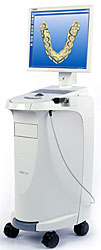 CEREC is a good preventative treatment for adults who already have extensive mercury fillings and children who already have decay in permanent teeth. It is the best preventive treatment because it allows restoration of your teeth with the strongest, longest lasting tooth-colored material available, with the least amount of your own tooth structure having to be removed. Your tooth is literally reconstructed with porcelain ceramic.
CEREC is a good preventative treatment for adults who already have extensive mercury fillings and children who already have decay in permanent teeth. It is the best preventive treatment because it allows restoration of your teeth with the strongest, longest lasting tooth-colored material available, with the least amount of your own tooth structure having to be removed. Your tooth is literally reconstructed with porcelain ceramic.
One of their greatest benefits to CEREC restorations is that they don’t wear out prematurely - and they don’t cause the opposing teeth to wear out prematurely either.
The finished CEREC porcelain ceramics are bonded directly onto the tooth, which means that more of your own healthy tooth is saved and your teeth are now stronger than before!
How are CEREC restorations made?
First, the dentist removes any old filling(s) and existing decay. The tooth is then scanned using a blue light scanner, and the exact dimensions are fed directly into the CEREC computer. A three dimensional picture of your tooth appears immediately on the computer monitor and you can watch the CEREC screen as Dr. Reid manipulates the 3D software. By using CEREC's CAD (Computer Aided Design) technology, the missing part of the tooth is designed to fit back in place, like the piece of a jigsaw puzzle. The result is a digitally customized and exact replacement for your tooth.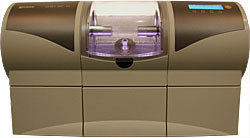 Next, the CEREC acquisition units then sends all the specific information to a robotic milling machine for processing. A ceramic block that matches the exact shading of your own natural tooth color is selected and placed in the milling unit, where a precise diamond-cut ceramic restoration is instantly created, just for you. Your dentist then quickly bonds this new custom-made restoration into place and any necessary adjustments are made for your comfort.Â
Next, the CEREC acquisition units then sends all the specific information to a robotic milling machine for processing. A ceramic block that matches the exact shading of your own natural tooth color is selected and placed in the milling unit, where a precise diamond-cut ceramic restoration is instantly created, just for you. Your dentist then quickly bonds this new custom-made restoration into place and any necessary adjustments are made for your comfort.Â
And voila! your CEREC restoration is now complete.
One of the best things for you is that the whole CEREC process avoids the use of messy impressions, packing string around the gums, wearing a temporary for 2 weeks, or having to return to be re-frozen to insert the permanent crown or inlay. Instead, the milling of the inlay is completed in about 12 minutes and bonded into place that day.
ID Dental - Inlays/Onlays
Dental inlays and onlays serve several purposes and are important treatment options in restorative dentistry. They can be used to restore strength, eliminate discomfort, and prevent tooth loss in rear teeth with mild to moderate decay. They can also repair rear teeth that have been fractured or damaged. Dental inlays and onlays made of tooth-colored material are used to replace traditional metal fillings for a more natural-looking appearance.
Dental inlays and dental onlays are similar in purpose; however, inlays are used to treat the indented top surfaces of teeth and onlays are used to treat larger surface areas. Both treatments generally require two office visits. In the first visit, impressions are taken of the patient's teeth that are used to create the dental inlays or onlays. Temporary inlays or onlays are placed to protect the teeth until the permanent inlays or onlays are placed in the second office visit.
Dental inlays and onlays can improve the health of your teeth and improve the appearance of your smile, and treatment requires no downtime.
The Difference between Dental Inlays and Dental Onlays
An inlay is similar to a filling and lies within the center of a tooth, this is called an inlay. These are custom-made to fit the cavity and then cemented into place. When the damaged tooth instead require inclusion of one or several points of the tooth, or even full coverage of the biting surface, this is described as an onlay. An onlay is therefore a more extensive reconstruction, but will still conserve more of the tooth structure in comparison to a crown.
Benefits with Dental Inlays and Dental Onlays
- Not likely to discolor over time as tooth-coloured resin fillings have a tendency to do.
- Preserve as much healthy tooth as possible and work as an excellent alternative to a crown when the damaged area is very small.
- An inlay is tailored after the tooth. While a composite filling can shrink with time, and the edges of a crown can sometimes not fit perfectly with the tooth, an inlay is tailored after all edges. This means that the tooth cleaning is easy.
- Dental inlays are better at sealing teeth to keep out bacteria, therefore they are preferred when the cavity is placed between the teeth.
- Extremely stable and long-lasting.
- Dental inlays and onlays only protect the weak areas of the tooth, which means that a full reshaping of the tooth is not necessary.
- An inlay will not stain.
Disadvantages with Dental Inlays and Dental Onlays
- More costly than amalgam or composite fillings
- The procedure is carried out during two appointments (instead of one for composite or amalgam filling)
- An inlay/onlay can fracture
Types of Inlays/Onlays
There are several types of inlays. Gold is the best option, but is usually only placed in areas of the mouth not very visible to others. Porcelain is usually preferred in the front teeth. Resin material inlays are the best options for patients who grind their teeth.
-
Porcelain Dental Inlays
Porcelain Dental Inlays are without a question the most common type of inlays/onlays in the front jawline. These are fully composed of porcelain with the purpose to make the tooth stronger by holding it together while retaining a natural esthetically pleasing color. The popularity comes from its strength, and potential to match the natural color of the damaged tooth. -
Gold Dental Inlays
Gold dental inlays/onlays are known for their durability and excellent strength. While a porcelain inlay is somewhat more brittle it is also more likely to break than a gold inlay. However, the gold inlays/onlays are commonly more expensive than the other materials available. As with porcelain inlays, the gold inlay/onlay is made in a dental laboratory. The dentist takes an impression of the prepared cavity and sends it to the laboratory, where the technician makes the inlay/onlay. When the inlay/onlay is created, the dentists remove the temporary filling and fix the inlay/onlay with dental cement. -
Other Dental Inlays
While the porcelain and gold dental inlays/onlays are the most common varieties, there are other types. Resin material inlays/onlays can be the best option for people who grind their teeth and those having a misaligned bite.
ID Dental - Implant Restorations
Dental Implants are small, titanium, screw-shaped threaded cylinders that are placed into the bone in the upper (maxillary) and/or lower (mandibular) arches of the mouth. They are used to replace one or many missing teeth, or to stabilize dentures. Titanium is an inert metal that is capable of creating a very tight bond with bone. Titanium is used in other operations such as knee or hip replacements -- so it is a proven surgical material.
The implant acts like the root of a natural tooth, and bone actually forms around the special coating of the implant to hold the implant firmly in place. This process is referred to as osseointegration. A crown, with the look, feel, and function of a natural tooth is then affixed to an abutment which is connected to the implant. The 'abutment' is simply a small connecting piece between the implant and the crown.
In cases where there are multiple missing teeth, or where the patient has previously had dentures, multiple implants are placed in the mouth to allow for implant-supported crowns or bridges, ball abutment retained overdentures, and/or bar-supported overdentures.
The success rate for dental implants is very high; and, with proper care, good dental hygiene, and a healthy life style, it is rare that implants will fail. Over the past 30 years, hundreds of thousands of implants have been placed. Many of the 'original' implants are still functioning without problems. Technology and procedures have advanced significantly since the first implants were placed. The success rate is now in the 95%+ range. Some reasons for failed implants can be attributed to an unhealthy lifestyle (smoking), or to poor dental hygiene.
What are the benefits of Dental Implants?
- There is a significant improvement in the overall quality of life for patients who have implant-supported or retained dentures, as opposed to standard or conventional (free-floating) dentures.
- Implants maintain, or realign, facial structure and profile, and preserve bone.
- Dental Implants are easy to clean, and do not decay.
- Implants help to preserve adjacent natural teeth. With an implant-supported bridge, there is no need to stress or traumatize adjacent natural teeth in order to hold the bridge in place. Traditional removable partial dentures also place stress forces on the remaining natural teeth.
- Implant-supported crowns and bridges have a longer functioning life than conventional crowns and bridges placed over natural tooth structure.
- Implants help to prevent the appearance of premature aging due to bone loss. Osteoporosis can accelerate bone loss with patients using standard or conventional dentures.
- Patients who wear conventional full dentures often experience difficulty eating, speaking and smiling. Implant-supported dentures virtually eliminate embarrassing denture slippage. The implants 'anchor' the dentures.
- Implants are cost effective when taking into account the functioning life of the implant.
If you desire to improve your smile and potentially
your quality of life then contact us today at 403.263.3136!
“Providing downtown Calgary, Gulf Canada Square and Bankers Hall dental clients with gentle, friendly and efficient dental care.â€
ID Dental
(Located at 2nd floor +15 Gulf Canada Square
across from Bankers Hall)
Dr. James Reid DDS
#245 Gulf Canada Square
401 - 9th Avenue SW
Calgary, Alberta T2P 3E4
Phone: (403) 263-3136
Email: info@iddental.ca
| Monday: | 7:30am to 4:00pm | |
| Tuesday: | 7:30am to 4:00pm | |
| Wednesday: | 7:30am to 4:00pm | |
| Thursday: | 7:30am to 4:00pm | |
| Friday: | 7:30am to 4:00pm | |
| Saturday: | 7:30am to 1:00pm | |
| Sunday: | Closed |
Copyright © 2016 ID Dental - All Rights Reserved | Privacy Policy | Terms of Use



